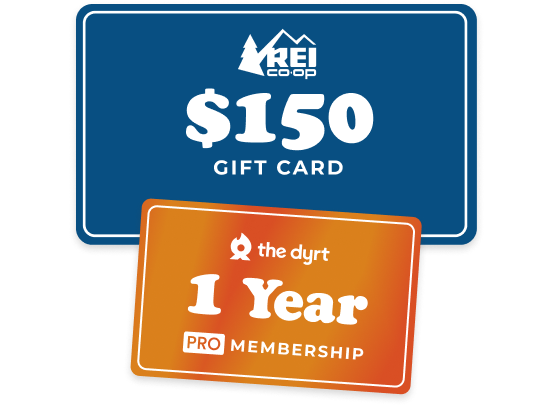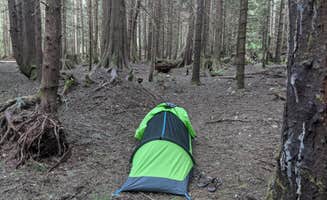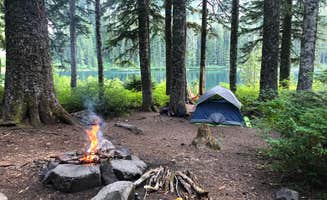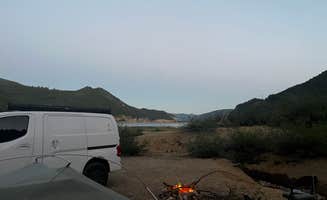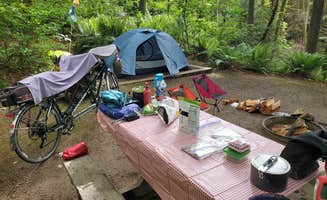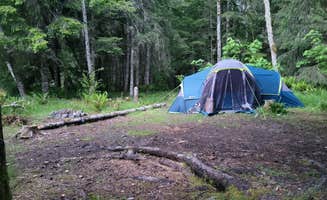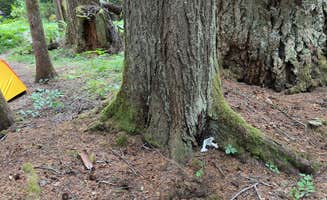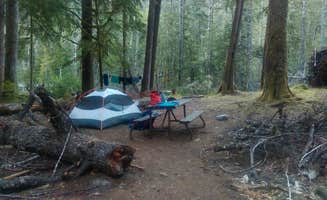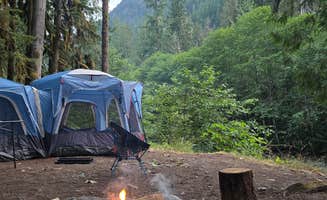Dispersed camping near Bellevue, Washington ranges from riverside spots to higher elevation sites nestled in the surrounding Cascade Mountains. Most free camping areas become accessible from late spring through early fall, with snow limiting access to higher elevation sites until June. The region receives 80-100 inches of precipitation annually, with summer nights cooling to 45-55°F even during warm months.
What to do
Fishing opportunities: At Keechelus Lake, campers can access prime fishing spots along the shoreline. The lake is stocked with rainbow trout and kokanee salmon. "Lovely camping area. Easy to find, felt very comfortable. So many spots up on the water," reports one camper.
Plane watching: The unique setup at Ranger Creek Airstrip Dispersed offers camping alongside an active runway. "This is such a cool place to camp! You are literally right on an active airstrip," notes one visitor. The log book indicates 3-5 small aircraft use the strip weekly during summer months.
Riverside relaxation: Multiple sites along Old Cascades Highway Dispersed provide direct access to flowing water. The sound creates natural white noise that masks other disturbances. "We could walk to the river and sit by it for the evening before heading back to the car to sleep," shares one camper.
What campers like
Accessibility from Seattle: Many appreciate how quickly they can reach these natural areas from the city. At South Fork Snoqualmie River Dispersed Site, one camper noted, "I travel and work remotely so I'm always looking for free places that have cell reception and this place hits the jackpot."
Variety of site configurations: Mountain Loop Hway Dispersed Camp offers different camping experiences along its route. "Meandering sites along the river with good logs for benches and fire rings made from forest rocks. Heavily forested and beautiful," shares one visitor who enjoyed the natural seating arrangements.
Cell service availability: Some sites maintain usable connectivity for those who need to stay connected. "I have Verizon and have 2-3 bars of service, it is very close to the interstate so you'll hear a constant hum of cars but it's very nice to feel like you have your own slice of the mossy old growth forest," reports a camper.
What you should know
Road conditions vary seasonally: Many forest service roads deteriorate after winter. A visitor to South Fork Snoqualmie River Dispersed Site warned, "Plenty of dispersed sites with fire pits. Some sites are close together however if you keep going down the road you'll find plenty of quiet and private places. They also are redoing the roads as I'm here so little to no potholes."
Weekday camping recommended: For quieter experiences, visit mid-week. One camper observed, "We were there during military skydiving practice. Very cool!" while another noted the difference in atmosphere: "I avoid the big holidays."
Pack sanitation supplies: Vault toilets often run out of supplies. "The southern one was out of tp, so bring your own septic safe stuff just in case," advised one camper. Other sites have no facilities at all, requiring proper waste management practices.
Tips for camping with families
Site selection for safety: Some areas have potential hazards for children. One visitor to South Fork Snoqualmie River Dispersed Site cautioned, "Lovely area such beautiful surroundings. But be very cautious as near one of the camp sites are very dangerous plants that are fatal and they are lined all around the campground so not recommended if you have children."
Consider noise levels: Families should be aware of noise from both natural and human sources. "We stayed on the east side of the strip and there is plenty of space and locations to settle," shared a visitor to Carbon River, while another noted, "I put up my hammock around 7pm, nobody else there. Around 9-11pm a few people including a 5th wheel arrived... They ran their generator, lights and music until 2:30am."
Research bathroom facilities: Joemma Beach State Park Campground offers better amenities than most dispersed sites. "If you like simple camping, this is a great place. There are about 16 campsites and you can walk down to the beach area. It is dog friendly, and they should be on leash."
Tips from RVers
Bridge restrictions: Some areas have limited access for larger vehicles. A reviewer of Carbon River mentioned, "I go every year, but unfortunately the only bridge to gain access to camping is closed until further notice."
Turnaround space: Consider how to exit when selecting sites. "This is my favorite dispersed site so far. Plenty of room for larger rigs, very close to a river and lots of woods to explore nearby," explains an RVer about Carbon River. "For larger rigs - take the second left at a Y-intersection, and then keep to the left and you won't have any trouble getting in. Going to the right at the Y takes you to an area that big rigs might have trouble finding spots or turning around."
Leveling challenges: Many free sites aren't graded flat. "It's a lovely area right by a beautiful river. However, it was hard to find a large enough spot that was also level to park our van," shared a visitor to Old Cascades Highway Dispersed.

